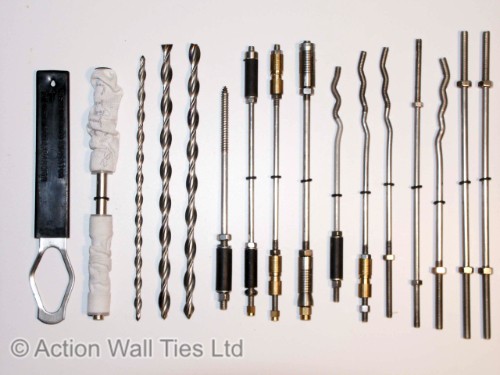Customer Stories
Learn about our previous projects, filter by property type, defect and our solution for each
Learn about our previous projects, filter by property type, defect and our solution for each
This overview of the history of cavity walls looks at how the use of cavity walls started. It also looks at some of the problems that property owners need to be aware of and how AWT can help to solve these issues. Read on to find out about:
Book your no-obligation, free survey today.
In many cases AWT can provide free advice, without a site visit, based on photos of the structural faults. Send us photos of the defect using our contact form or email us.
Cavity wall construction has almost entirely replaced solid wall construction in the United Kingdom. It evolved in the latter years of the nineteenth century and became common in dwellings in northern and western Britain in the early 1900s.
Its widespread adoption as virtually standard in the construction industry happened throughout the building booms of the 1920s, ‘30s and ‘40s.
The gallery above shows the typical outer leaf (the external brickwork) of a cavity wall and the type of damage often associated with failing cavity wall ties.
When identifying whether a wall is of solid or cavity construction, something to be aware of is that the presence of headers in the brickwork (bricks laid with the smallest side facing out) is not always indicative of solid brickwork.
From the mid-1940s to the mid-1950s, “snapped headers” were often used in cavity wall construction to emulate the English bond brickwork pattern that was common in solid brickwork.
Action Wall Ties can help identify whether your property has cavity walls or solid brickwork and diagnose the underlying cause of structural defects.
In the early years, the skins of these cavity walls were held together by metal ties made from cast or wrought iron, mild steel or copper.
The corrosion of wall ties was first officially recognised in the 1960s in South Wales. At first, it was thought to be due to a combination of poor tie protection and exposure to the elements. Time has shown that many of the early ties and mortars were just more susceptible to corrosion.
Mild steel ties initially were either left unprotected or given a bitumen coating, but in the early 1930s zinc coatings or galvanising became accepted.

The most common type of mild steel ties (under BS 1234) are strip ties (commonly known as vertical twist or fishtail) and wire ties (commonly known as butterfly or double triangle). The photo shows a range of traditional wall ties, all of which are prone to corrode and fail over time. In contrast, modern wall ties are carefully designed for strength and durability.
It is very difficult to predict the life expectancy of ties used in the construction of houses before 1945.
However, it can be fairly accurately predicted for those built between 1945 and 1964 :
The expected life of ties used in construction between 1964 and 1981 is estimated at:
ALL mild steel wall ties will eventually corrode – the only question is when!
As shown in the photo, Action Wall Ties can survey cavity wall ties by drilling small inspection holes and using an endoscopic camera to assess the wall ties. Contact us to arrange a wall tie survey.

The key here is catching the problem as early as possible. If the symptoms are recognised before deterioration has progressed too far, the walls may be re-stabilised rather than needing to be re-built.
Old ties must be located using an electronic detector and replaced with a suitable corrosion-resistant remedial fixing.
Finally, existing ties will need to be isolated to prevent further damage to the outer leaf of brickwork. Corrosion of a tie within the inner leaf of a cavity wall is unlikely to become significant as they are embedded in a dry environment.
AWT’s specialist equipment allows them to isolate failing wall ties and install remedial wall ties with minimal disruption by working from the outside of the building.
Ferrous oxide (rust) will result when embedded mild steel wall ties corrode. This will expand to several times the thickness of the metal it has resulted from, often breaking through the outer leaf of the brickwork (sometimes splitting the bed joints) and causing either lifting or bowing of the walls and damage to internal finishes.
From a structural perspective, this leaves the wall vulnerable to vertical and wind loads, especially in the case of large gable and unreturned walls. The instability of the wall will eventually result in the ties corroding away completely, necessitating the rebuilding of the wall. The gallery shows how corrosion causes the cavity wall ties to lose strength and eventually crumble away.
As shown below, Action Wall Ties uses a range of modern cavity wall ties that are far superior to traditional wall ties. Using their many years of experience, AWT selects the most appropriate remedial wall tie style for each project.

There are 3 main types of replacement wall ties:
All AWT’s replacement wall ties are made from high-grade stainless steel. They are designed to restore structural integrity and provide a long lasting solution to cavity wall tie issues.
Equipment designed by AWT can also realign brickwork that is bulging and bowing due to failing wall ties before installing new wall ties and lateral restraints.
Kent based Action Wall Ties (AWT) are specialists in wall tie surveys and replacement, providing professional solutions to a wide variety of cavity wall problems. We serve domestic and commercial customers, local authorities, housing associations and insurance companies across London, Kent, Essex, Sussex and Surrey.
Contact us to discuss your requirements or book a survey on 01227 721 255, or email us.
Our specialist structural repair contractors will be happy to help provide a comprehensive and permanent repair to your structural problems.





